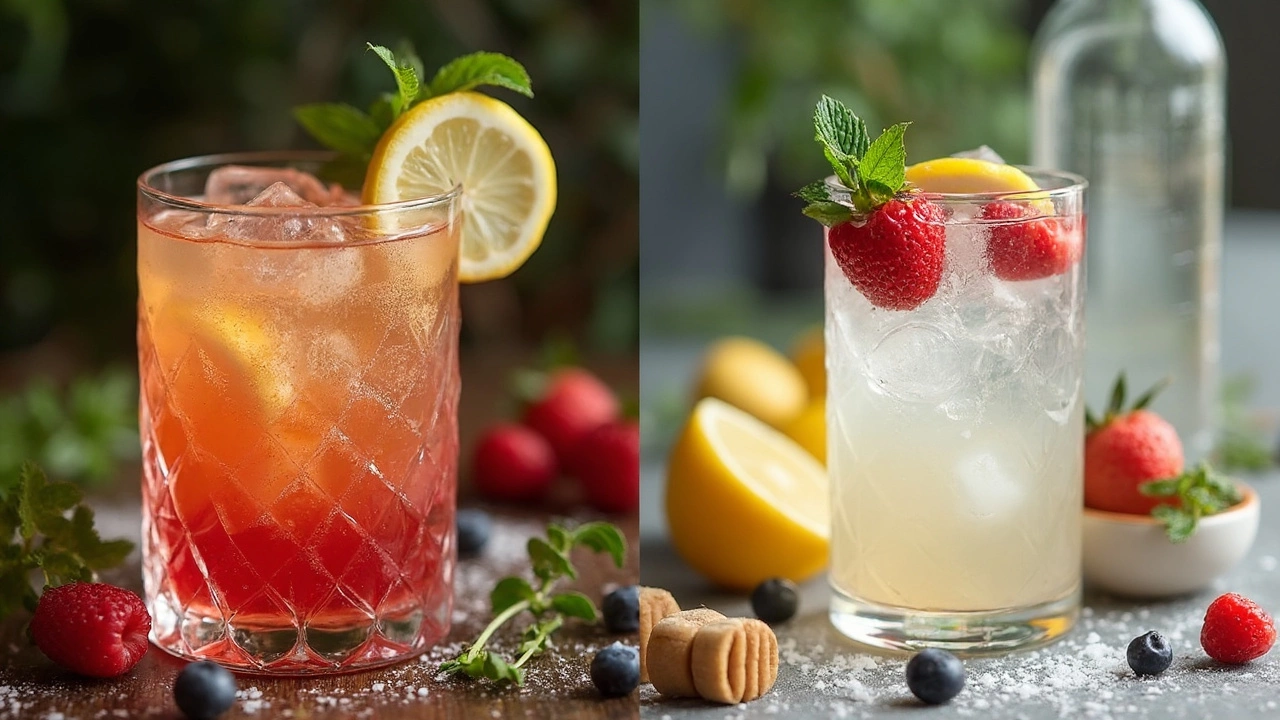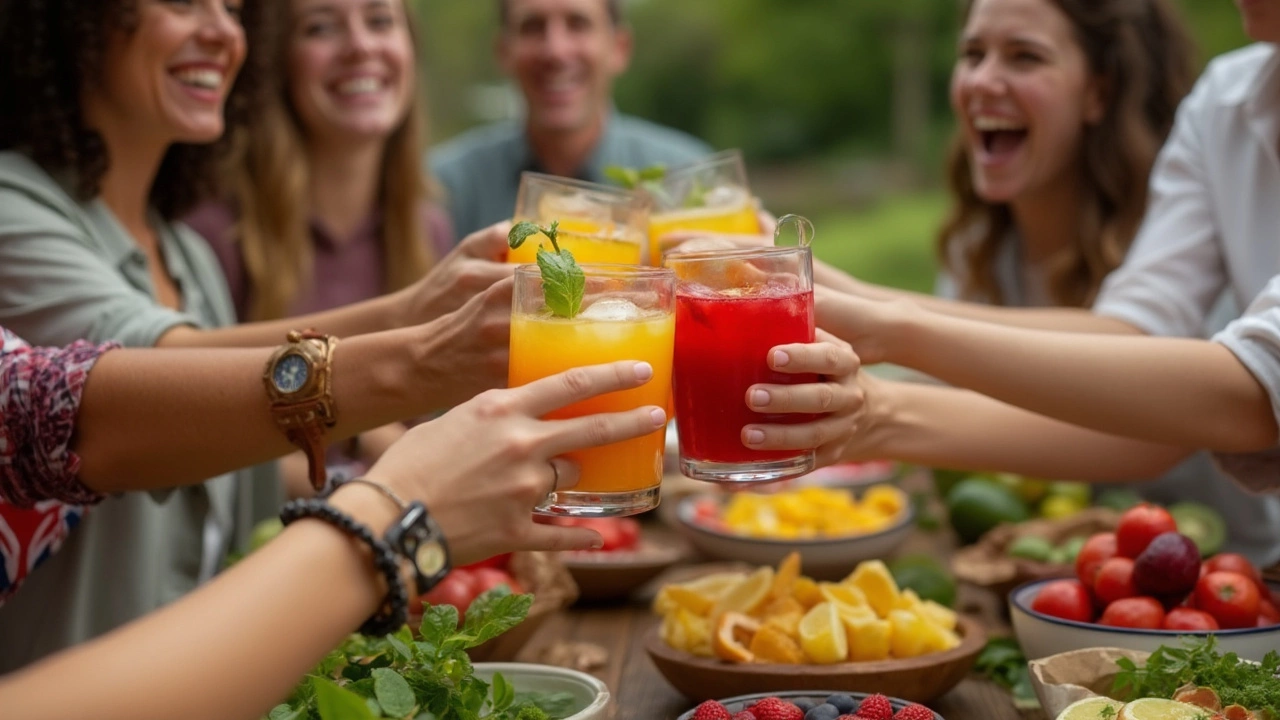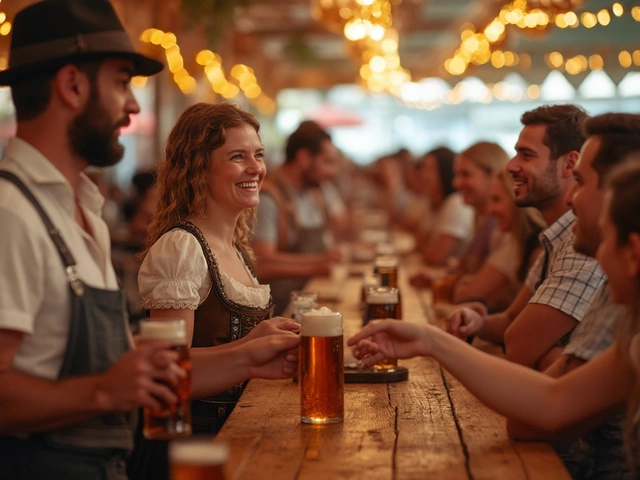People always say mocktails are the healthier choice, but is it really that simple? Take a look at what happens when you swap out your favorite cocktail for a booze-free version. Sure, the alcohol’s gone, but there’s more to these drinks than what’s left in your glass.
If you stop at a bar and order a mojito, you know you’re getting rum, sugar, lime, and soda. Ask for a mocktail mojito? You’ll skip the rum, but you might get extra sweet syrup without even realizing it. Sometimes, those fancy non-alcoholic drinks have more sugar than their alcoholic cousins.
The real question isn’t just 'cocktail or mocktail,' but what actually goes into the drink. When you know how to spot the sugar bombs and calorie traps, you can make way better choices—without missing out on the flavor. Let’s figure out if mocktails really deserve their healthy reputation or if they’re just cocktails in disguise.
- What Makes a Mocktail Different?
- How Alcohol Impacts Your Body
- The Hidden Sugar Problem
- Are Mocktails Always the Healthier Choice?
- Tips for Healthier Mocktails
- Mocktail Ideas to Try at Home
What Makes a Mocktail Different?
The big difference between a mocktail and a cocktail is whether or not there’s alcohol. A cocktail—think margarita, martini, or whiskey sour—gets its punch from spirits like vodka, rum, gin, or whiskey. A mocktail skips the booze completely. Sounds obvious, right? But there’s more to it once you look closer.
Mocktails are built just like cocktails. They use similar basics: juices, sodas, herbs, fresh fruit, and sometimes special syrups. Bartenders might muddle mint, squeeze citrus, or rim a glass with salt for both. Without alcohol, the flavor has to come from somewhere else. That usually means more juices or sweet mixers to keep things tasty—sometimes a little too tasty. It’s not weird to see mocktails with the same (or more) sugar than their cocktail twins.
Here’s a basic comparison of what usually goes into each one:
| Drink Type | Main Ingredients | Common Additives | Calories (average) |
|---|---|---|---|
| Mocktail | Fruit juice, soda, herbs, syrups | Sugar, artificial flavors | 90-180 |
| Cocktail | Alcohol, juice, soda, herbs | Sugar, bitters | 120-250 |
You might notice that the calorie count for mocktail drinks isn’t always low. Sometimes, dropping the alcohol just leaves more room for sugar. Mocktails don’t get you buzzed, which is great if you’re driving or have health concerns. You still have to watch what else is in the glass, though.
One thing mocktails do better is cater to everyone. No hangovers, no drunk texts, and you don’t have to worry if your friend is skipping alcohol for any reason. It’s a good way to keep social events inclusive without losing out on the fun.
So, the core of it? No spirits, but still lots of flavor. Just remember to check the ingredients—what you pull from the bar or fridge matters more than the label 'mocktail' or 'cocktail.'
How Alcohol Impacts Your Body
Ever wonder what actually happens after you have a drink? When you sip a cocktail, alcohol goes straight into your bloodstream—fast. Right from the start, it can hit your brain and mess with your coordination, judgment, and mood. That's why drinks can go from "fun" to "bad idea" quicker than most people expect.
But it isn’t just about feeling tipsy for a few hours. Regular alcohol can mess with your health long-term. It puts extra work on your liver, which tries to break down alcohol so the rest of your body can handle it. Too much, too often, and your liver gets worn out. That’s where folks end up with fatty liver, inflamed liver, or worse.
If you think it stops there, think again. Here's a quick look at what alcohol can do to different parts of your body:
- Brain: Slows your thinking and reflexes; can boost anxiety or depression
- Liver: Buildup of fat, inflammation, and even long-term damage
- Heart: Raises blood pressure and increases risk for heart disease
- Gut: Messes with digestion and could give you heartburn
- Sleep: Might knock you out, but it wrecks deep sleep and energy the next day
And here’s a quick side-by-side on how your body reacts to one night of heavy drinking versus regular, moderate drinking:
| Drinking Style | Short-Term Effects | Long-Term Effects |
|---|---|---|
| Binge (4+ drinks) | Slurred speech, lost memory, risky behavior | Liver damage, higher cancer risk, weak immune system |
| Light/Moderate (1 drink) | Relaxed feeling, mild buzz | Still possible heart and liver impact if it becomes daily |
If you struggle with anxiety, want to keep your liver healthy, or just want better sleep, skipping the alcohol in your mocktail is a solid move.
The Hidden Sugar Problem
When people swap out cocktails for mocktails, they often think they're dodging the main health pitfall: alcohol. The thing is, the secret troublemaker in both drinks is plain old sugar. A mocktail can pack in serious sugar, sometimes without you even noticing. If you order a strawberry daiquiri mocktail and it tastes just like the real thing, that's probably because of all the sweet syrup and fruit juice.
Here’s the thing—mocktails can easily hit (or pass) your entire daily recommended sugar intake in just one glass. For adults, the World Health Organization suggests no more than 25-36 grams of added sugar per day. One "virgin" piña colada from a popular chain restaurant can have around 70 grams of sugar. That’s almost double the daily limit, just from your drink.
| Drink | Average Sugar (grams) |
|---|---|
| Classic Margarita Cocktail | 24g |
| Mocktail Margarita (bar version) | 30g |
| Piña Colada Cocktail | 32g |
| Virgin Piña Colada | 70g |
| Lemonade-based Mocktail | 40g |
| Gin & Tonic | 14g |
This isn’t just about calories. Too much added sugar can lead to headaches, mood swings, and eventually make you more likely to get diabetes or gain weight.
The sugar problem often hides in these places:
- Pre-made drink mixers (check those bottles behind the bar—they pack a punch)
- Syrups (even the "natural" ones like agave or honey still count as added sugars)
- Fruit juices (a splash can be fine, but a glass is another story)
- Sodas (even the tonic in a classic G&T adds sugar)
If you want a healthier drink, pay just as much attention to the sugar as you do to the alcohol. Reading the menu, asking how your drink is made, or making your own with fresh ingredients are great ways to make sure you aren't trading one problem for another.

Are Mocktails Always the Healthier Choice?
It’s tempting to think going for a mocktail means you’re making a healthy call. Ditch the booze, gain some points, right? Honestly, it’s not always the case. Mocktails dodge the short-term alcohol effects like hangovers and the long-term risks linked with alcohol, such as liver damage and higher cancer risk. But let's not call them saints just yet.
You have to keep an eye on what else goes in that glass. Sweetened mixers, flavored syrups, fruit juices—these are often loaded with sugar. The American Heart Association says most adults should stick to no more than 36 grams of added sugar a day for men and 25 grams for women. Just one big mocktail can push you past that limit.
Take a look at this side-by-side example:
| Drink (8 oz) | Calories | Alcohol | Added Sugar (g) |
|---|---|---|---|
| Classic Margarita | 200 | Yes | 12 |
| Mocktail Margarita | 180 | No | 25 |
See the catch? The mocktail skips the tequila but can double up on sugar to make up for flavor. That’s a fast track to energy crashes and if you drink them often enough—possible weight gain or even blood sugar spikes if you have diabetes risk.
Plus, not all non-alcoholic cocktails pack any real nutrients. Swapping spirits for juices or sodas without adding fresh herbs, actual fruit, or a splash of seltzer doesn’t offer much beyond hydration.
"Just because a drink is alcohol-free does not automatically make it healthy. Watch the sugar, calories, and additives—your body will thank you," says Jaclyn London, RD, a well-known dietitian and nutrition consultant.
Here’s what to watch for if you want your mocktail to actually be better for you:
- Stick to smaller servings. Huge glasses mean more sugar and calories.
- Ask for less syrup or sugar, or swap some juice for sparkling water.
- Use fresh fruit or herbs for natural flavor—it looks cooler and tastes better.
It comes down to ingredients and balance. So, while mocktails can be healthier than cocktails, the real win is making smart tweaks to what’s inside your glass.
Tips for Healthier Mocktails
If you want your mocktail to actually be a better choice than a cocktail, watch out for sneaky sugar and empty calories. Here’s how to make your mocktail work for you and not against your health.
- Use fresh ingredients. Skip the store-bought mixes and syrups—they almost always pack in loads of sugar. Go for fresh citrus, berries, cucumber, mint, or even ginger. They add real flavor without the junk.
- Sweeten smart. If you want sweetness, swap white sugar or simple syrup for a splash of 100% juice, mashed fruit, or a drop of honey or agave. Stevia or monk fruit sweetener can work too if you want zero calories.
- Watch your mixers. Tonics, soda, and energy drinks sound innocent but are sometimes sugar bombs. Seltzer, club soda, or unsweetened tea are safer bets and just as refreshing.
- Add something extra (but healthy). Try throwing in a little apple cider vinegar, fresh herbs, or even a few chia seeds. They bring more depth to the drink—and a few vitamins can’t hurt.
- Check servings. A mason jar of mocktail feels fun, but if it’s loaded with juice, those calories sneak up on you. Smaller glasses mean you sip slower and don’t overload on sugar.
One trick a lot of bartenders use? Add a little bit of bitters for balance and complexity, even in non-alcoholic drinks. Most bitters have trace alcohol, but you’re talking just a few drops—so unless you’re totally avoiding, it’s usually fine.
Last thing—don’t be afraid to experiment. Grab a few fresh ingredients and test out combos until you find something you actually crave. Healthy doesn’t have to mean boring.
Mocktail Ideas to Try at Home
Ready to skip the hangover and keep things fresh in your glass? Making your own mocktail at home is easier than you might think, and you control exactly what goes in—so you can dodge the extra sugar and weird additives hiding in a lot of store-bought mixers.
First rule: fresh ingredients matter. Fresh fruit, herbs, and a little fizz can turn a boring drink into something you'll actually crave on a hot day or when chilling with friends. Here are a few simple ideas you can whip up, even if your bar skills are pretty basic:
- Cucumber Mint Spritz: Slice half a cucumber and toss it into a glass with a handful of fresh mint leaves. Muddle them together. Add ice and top with soda water and a squeeze of lime. Super refreshing and no added sugar.
- Berry Lemon Fizz: Grab a handful of mixed berries (frozen works if you’re out of fresh). Mash them in the bottom of your glass, add the juice of half a lemon, fill with ice, and pour over sparkling water. You can sweeten with a splash of honey if you want, but keep it minimal.
- Spicy Pineapple Cooler: Mix fresh pineapple chunks with a few slices of jalapeño and crush them gently. Add ice, top with club soda, and finish with a lime wedge. Perfect if you want something with a little kick.
- Virgin Bloody Mary: Mix low-sodium tomato juice with fresh lemon juice, a dash of Worcestershire, hot sauce, celery salt, and black pepper. Give it a good stir, pour over ice, and garnish with celery. You get all the flavors of the classic without the vodka.
- Herbal Citrus Smash: Combine orange and grapefruit slices with a few sprigs of rosemary. Muddle, then fill your glass with ice and a splash of tonic or sparkling water. Big, bold flavors, zero alcohol.
If you want to cut down even more on sugar, skip simple syrups completely and lean on fresh fruit and herbs for flavor. Need more fizz? Club soda and sparkling water have almost no calories and zero sugar, so you can keep sipping guilt-free.
The real trick is experimenting. Don’t be afraid to swap in your favorite fruits or herbs, or play with spice if that’s your thing. A good mocktail is about what you like, not what a recipe tells you. With a little creativity, you’ll never miss the alcohol.


